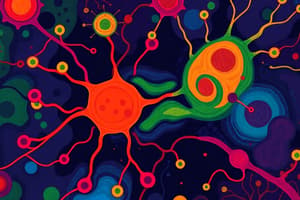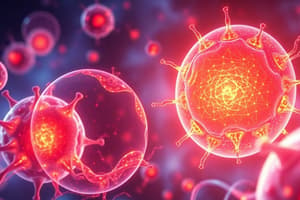Podcast
Questions and Answers
What are the general principles of cell signalling?
What are the general principles of cell signalling?
Reception, Transduction, Response
Which of the following are characteristics of cell signalling? (Select all that apply)
Which of the following are characteristics of cell signalling? (Select all that apply)
- Amplification (correct)
- Randomness
- Specificity (correct)
- Feedback (correct)
What type of signalling is described by contact dependent communication?
What type of signalling is described by contact dependent communication?
- Synaptic
- Endocrine
- Juxtacrine (correct)
- Paracrine
Estrogen activates only nuclear hormone receptors.
Estrogen activates only nuclear hormone receptors.
What are the primary components that regulate nuclear receptors?
What are the primary components that regulate nuclear receptors?
Cells that secrete steroid hormones contain abundant smooth ______ reticulum.
Cells that secrete steroid hormones contain abundant smooth ______ reticulum.
Which of the following hormones are examples of peptide hormones?
Which of the following hormones are examples of peptide hormones?
Flashcards are hidden until you start studying
Study Notes
General Principles of Cell Signalling
- Cell signaling is a process that allows cells to communicate with each other and their environment.
- Four main stages: reception, transduction, response, and termination
- Reception: cells receive signals from their surroundings using receptors
- Transduction: the signal is converted into a form that can be understood by the cell
- Response: the cell responds to the signal, often by changing its behaviour or gene expression
- Termination: the signaling pathway is shut off, preventing an overreaction
Characteristics of Signalling
- Specificity: signals are recognized only by specific receptors
- Amplification: a single signal molecule can trigger a cascade of events, amplifying the signal
- Network: signaling pathways can interact with each other, creating complex networks
- Feedback: signaling pathways are regulated by feedback mechanisms, ensuring proper control
Types of Cell Signalling
- Juxtacrine: cells signal each other through direct contact
- Paracrine: cells signal nearby cells through secreted signaling molecules
- Synaptic: specialized form of paracrine signaling used by neurons to communicate across synapses
- Endocrine: cells signal distant cells through hormones that travel in the bloodstream
Hormone Types and Receptors
- Hormones: secreted signaling molecules that travel throughout the body
- Types:
- Proteins: like adrenocorticotrophin
- Glycosylated proteins: like thyroid-stimulating hormone
- Peptides: like vasopressin
- Monoamines: like norepinephrine
- Amino acid derivatives: like melatonin
- Steroids: like cortisol
- Lipids: like prostaglandins
- Receptors: proteins that bind to hormones and initiate the signaling cascade
- Receptor Location:
- Cell membrane: for water-soluble hormones
- Nucleus: for lipid-soluble hormones
Hormone Synthesis
- Protein and peptide hormones: synthesized through a classical DNA-mRNA-protein pathway
- Lipid-based hormones: synthesized from precursors, like cholesterol
Roles of Cell Organelles in Hormone Synthesis
- Steroid hormone-secreting cells: contain abundant smooth endoplasmic reticulum (SER)
- Peptide hormone-secreting cells: contain abundant rough endoplasmic reticulum (RER)
Examples of Peptide Hormone Secreting Cells
- Alpha cells: in the islets of Langerhans, secrete glucagon
- Beta cells: in the islets of Langerhans, secrete insulin
Reception
- Most ligands: bind to cell surface receptors
- Exceptions: steroid hormones and thyroid hormones, which bind to intracellular receptors
Slow and Fast Hormone Responses
- Fast responses: occur within minutes, usually involving changes in protein activity
- Slow responses: take hours or days to occur, usually involving changes in gene expression
Nuclear Receptors
- Location: in the nucleus or cytoplasm
- Function: regulate gene transcription
- Structure: usually have three domains:
- Ligand-binding domain: binds to the hormone
- DNA-binding domain: binds to DNA
- Activation function domain: regulates gene transcription
- Ligands: primarily steroids and lipid-based hormones
- Exceptions:
- Triiodothyronine (T3)
- Oestrogen
Examples of Nuclear Receptors
- Steroid receptors: bind to steroid hormones
- Thyroid hormone receptors: bind to thyroid hormones
- Retinoid receptors: bind to retinoids
- Vitamin D receptor: binds to vitamin D
Studying That Suits You
Use AI to generate personalized quizzes and flashcards to suit your learning preferences.



